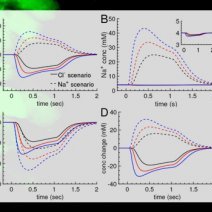Ca2+-activated Cl- current ensures robust and reliable signal amplification in vertebrate olfactory receptor neurons
Johannes Reisert and Jürgen Reingruber.
Abstract
Activation of most primary sensory neurons results in transduction currents that are carried by cations. One notable exception is the vertebrate olfactory receptor neuron (ORN), where the transduction current is carried largely by the anion Cl−. However, it remains unclear why ORNs use an anionic current for signal amplification. We have sought to provide clarification on this topic by studying the so far neglected dynamics of Na+, Ca2+, K+, and Cl− in the small space of olfactory cilia during an odorant response. Using computational modeling and simulations we compared the outcomes of signal amplification based on either Cl− or Na+ currents. We found that amplification produced by Na+ influx instead of a Cl− efflux is problematic for several reasons : First, the Na+ current amplitude varies greatly, depending on mucosal ion concentration changes. Second, a Na+ current leads to a large increase in the ciliary Na+ concentration during an odorant response. This increase inhibits and even reverses Ca2+ clearance by Na+/Ca2+/K+ exchange, which is essential for response termination. Finally, a Na+ current increases the ciliary osmotic pressure, which could cause swelling to damage the cilia. By contrast, a transduction pathway based on Cl− efflux circumvents these problems and renders the odorant response robust and reliable.
Proc Natl Acad Sci U S A. 2018 Dec 31. pii : 201816371. doi : 10.1073/pnas.1816371116.


